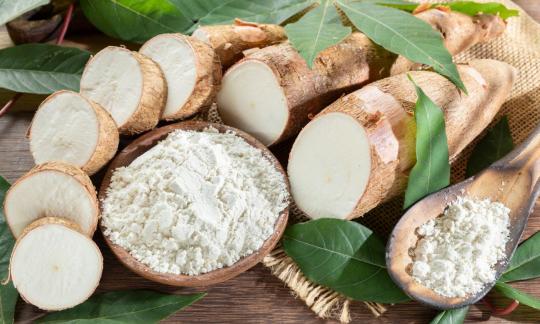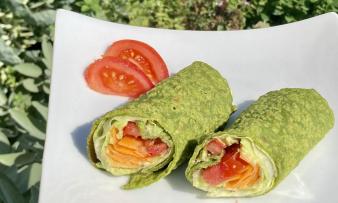Tapioca starch, also called manioc starch, is used to bind and thicken sauces and soups. It is tasteless and naturally gluten-free, but not raw. Make sure it is organic quality.
Use in the kitchen
Tapioca starch is particularly popular in Asian and African cuisine, as well as in South America. The starch obtained from the cassava root has a neutral taste, is vegan and gluten-free (not raw). This means that it can be used in numerous dishes without affecting their taste. Cassava starch is used as a substitute for potato starch or corn starch and, unlike other starches, gives the respective dish an additional smooth consistency. It is an ideal binding agent for sweet or savory soups and sauces and can also be used to make gluten-free and vegan pastries, pastries and desserts (such as puddings or cream dishes). It is also sometimes used to make glass noodles or rice paper for summer rolls. It can also be used for gluten-free bread or wraps (see recipe Spinach and chickpea wraps with raw vegetable filling). In Brazil, "tapioca" means a thin crêpe made from tapioca flakes, which can be filled and eaten with both sweet and savory fillings.
Tapioca starch is primarily available in powder form. There are also tapioca balls (tapioca pearls), which, unlike the powder, are mainly used for the popular bubble tea and for preparing desserts. They are originally white, but can take on a variety of colors using fruit syrup or food coloring. Since the balls are also made of starch, they can basically be used in the same way as the starch in powder form (especially the slightly smaller balls). The powder can sometimes be a little easier to measure for preparing dishes.
Vegan recipe for cold strawberry soup with tapioca starch
Ingredients (for 4 people): 40 g tapioca starch (organic), 400 ml oat milk, 100 ml oat cream, 20 g sugar, 500 g strawberries, 400 g watermelon, 1 tbsp lemon juice, 100 ml apple juice, peppermint leaves (to garnish).
Preparation: Put the tapioca starch in a bowl, cover with hot water and leave to soak for about 10 minutes. Bring the oat milk to the boil with the oat cream and 10 g of sugar and reduce the heat to the lowest setting. Add the tapioca starch, stir in and simmer for about 10 minutes. Remove the pan from the heat and allow to cool. Wash and chop the strawberries. Dice the melon into pieces and puree both in a blender with the lemon juice, the remaining sugar and 100 ml of apple juice. Stir in the tapioca mixture and add more apple juice depending on the desired consistency. Chill the vegan strawberry soup for 1 hour, divide between four bowls, garnish with peppermint leaves and serve.
Vegan recipes with tapioca starch can be found under the note: " Recipes that have the most of this ingredient ".
| Not only vegans or vegetarians should read this: Vegans often eat unhealthily. Avoidable nutritional mistakes. |
Purchasing - Storage
Large retailers such as Coop, Migros, Denner, Volg, Spar, Aldi, Lidl, Rewe, Edeka, Hofer, Billa or organic supermarkets such as Denn's Biomarkt and Alnatura generally do not sell tapioca starch. Better opportunities are offered by online retailers, health food stores, drugstores or Asian shops, where it is available all year round.
The availability of tapioca starch varies depending on the size of the store, catchment area, etc. Our recorded food prices for the DA-CH countries can be found above under the ingredient image - and by clicking you can see their development at various suppliers.
Storage tips
Tapioca starch is best stored in a cool, dry place in an airtight container.
Ingredients - Nutritional values - Calories
100 g of tapioca starch provides 348 kcal of energy. This includes 0.2 g of fat, 87 g of carbohydrates and 0.6 g of protein. 1
The iron content is 1 mg/100g. This covers 7% of the daily requirement. Breadcrumbs (1.2 mg/100g) and soft wheat semolina (1.2 mg/100g) have similar values. Herbs, nuts, seeds and kernels are particularly good sources of iron, e.g.dried pumpkin seeds (8.8 mg/100g). 1
100 g of tapioca starch contains 0.10 mg ofriboflavin (vitamin B2) (7% of the daily requirement). Light spelt flour (type 630 or D 700) orvanilla powder have the same high values, although the latter is usually only used in very small amounts. Good plant-based sources of vitamin B2 are yeast, nuts, mushrooms, oil seeds, pulses, whole grains and herbs, e.g. almonds (1.1 mg/100g) or yeast flakes (4 mg/100g). 1
Calcium is present at 12 mg/100g, which covers 2% of the daily requirement. Coconut flour (13 mg/100g) and rice flour (10 mg/100g) have similar values. Dark green vegetables and herbs are particularly good sources of calcium, e.g. rocket (160 mg/100g) and kale (150 mg/100g). 1
The complete ingredients of tapioca starch, the coverage of the daily requirement and comparison values with other ingredients can be found in our nutrient tables. In the article Nutrients explained you will get a detailed insight into the topic.
Health Effects
Since cassava starch does not naturally contain gluten, it is ideal for people with gluten intolerance (celiac disease) or gluten sensitivity.
It also contains small amounts of resistant starch (about 1%). Starch is divided into three categories based on its nutritional value: rapidly digestible starch, slowly digestible starch and resistant starch. The term resistant starch (RS) refers to the sum of starch and starch breakdown products that are not absorbed by the small intestine of a healthy person. Studies suggest that slowly digested starch and resistant starch have significant effects on human health. Resistant starch enters the large intestine, where microorganisms ferment it, producing mainly short-chain fatty acids. As a result, resistant starch has positive effects on diabetes, some cancers, cardiovascular disease, gut health, obesity and osteoporosis. Resistant starches have been shown to have equivalent and/or better effects on human health than conventional fiber-enriched foods. However, the potential health benefits vary greatly with study design and differences in the type and amount consumed. 3 Foods that contain higher amounts of resistant starch include pulses or cooked and cooled potatoes.
For underweight people, tapioca starch can help them gain weight because of its high calorie count.
Secondary plant substances
Many of the health effects of cassava can be attributed to the secondary plant substances it contains. Our article on secondary plant substances provides an overview of the classification of substance groups, their occurrence in foods and possible effects on humans. However, we do not know how many of the bioactive substances contained in cassava are also available in the starch obtained from it (tapioca starch). Cassava itself contains the following secondary plant substances, among others: 2.15
- Isoprenoids: Triterpenes: oleanolic acid, saponins (saponosides), squalene, lupeol, steroids (stigmasterol, campesterol,beta-sitosterol); Diterpenes/oids: Yucalexine, Ent-Pimaran, Ent-Atisan, Ent-Kauran
- Alkaloids
- Polyphenols: Flavonoids: flavonols (rutin, kaempferol), flavones (apigenin), glycoside flavonoids (nicotiflorin), flavanols (gallocatechin, catechin, catechin gallate), anthocyanins (leucoanthocyanins); tannins (phlorotannin); Phenolic acids: hydroxybenzoic acids (gallic acid)
- Other nitrogen-containing compounds: Cyanogenic glucosides (linamarin, lotaustralin, amygdalin)
- Other organic compounds: coumarins (scopoletin, scopolin, esculetin, esculin); alcohols (glycerol); carboxylic acids (levulinic acid); quinones (cochlioquinone B)
However, it should be noted that the composition of secondary plant substances in cassava can vary depending on the variety, time of harvest and growing conditions. Therefore, quantities are only of limited use and can only be understood roughly.
The results of some studies show that cassava leaves, stems and roots have wound-healing, anti-cancer and antihypertensive properties. These plant organs contain plenty of secondary plant substances such as terpenoids, flavonoids, phenolic acids and nitrogenous compounds such as amygdalin, which contribute significantly to the health effects. Antibacterial, antioxidant and anti-inflammatory effects have been observed. Amygdalin in particular, which is toxic in high doses, has been shown to be effective in the treatment of cancer and inflammatory diseases when microdosed. 2,15 However, a laboratory study showed that although amygdalin is found in all parts of the cassava plant, the processed tapioca starch no longer contains any of this substance. 15
A research study in Benin revealed that people use cassava both as a food and to treat diseases of microbial and viral origin. The bioactive compounds in cassava are believed to help treat and prevent metabolic disorders, diabetes and heart disease. The different parts of the cassava plant are also used to treat diseases such as asthma, bronchitis, emphysema and leprosy. 2,15 However, despite extensive research, we were unable to determine whether the results of the studies on cassava also apply to tapioca starch.
Dangers - Intolerances - Side effects
Tapioca starch has a rather poor nutritional profile, 4 as it consists almost exclusively of carbohydrates and contains very little protein, fat andfiber. 1 People who suffer from diabetes should therefore consume the starch with caution. The micronutrients are also sometimes only present in very small quantities, even in 100 g, and are not sufficient to cover daily needs. 1 The nutritional profile of tapioca starch, however, could be significantly improved in experiments with the addition of soy flour. 4
Although cassava roots and products derived from them are staple foods in many countries, they can have harmful effects on health if they are not prepared properly or eaten raw. Cassava contains four or five cyanogenic glycosides. The most common are linamarin and lotaustralin, which are found in both the leaves and the roots. 5 Cyanogenic glycosides are plant poisons that are non-toxic in themselves, but when broken down in the human or animal organism they release the toxic substance hydrogen cyanide. 6 Epidemiological studies show a link between the outbreak of the neurodegenerative disease Konzo and the chronic consumption of inadequately processed cyanogenic cassava (tapioca). Outbreaks of Konzo have occurred in the Democratic Republic of Congo, Mozambique, Tanzania, the Central African Republic, Angola, Cameroon and most recently in Zambia. Biochemical and toxicological studies suggest that linamarin metabolites, particularly cyanide, thiocyanate and cyanate, may play an important role in the pathogenesis of konzo. In addition, susceptibility factors such as genetics, poor nutrition and poverty or their interactions are suspected to contribute to the development of the disease. Since there is no cure for konzo, prevention of the disease remains of utmost importance. 7
The development of cretinism and goiter or disorders of thyroid metabolism are also associated with high and one-sided consumption of cassava, combined with a diet low in protein and iodine. 8 By appropriately processing cassava, which generally involves drying in the sun, grinding and grating, pressing, immersion in water, fermentation, roasting or cooking, or usually a combination of these processes, the glycosides can be eliminated, causing the highly volatile hydrocyanic acid to escape into the ambient air. 5
Due to the complex manufacturing process, industrially produced tapioca starch does not contain harmful amounts of linamarin and is safe to consume, but is never raw and certainly not raw food quality.
Ecological footprint - animal welfare
The ecological footprint of a food depends on various factors. The type of agricultural production (conventional vs. organic), seasonal, regional or domestic production or import by truck, ship or plane, different types of packaging and whether the goods are fresh or frozen all play a decisive role. 9
The CO 2 footprint for the production of tapioca starch varies depending on the manufacturer. For 1 kg of tapioca starch, the CO 2 footprint is estimated at 0.86 kg CO 2 eq/kg. 10
Larger quantities of water are needed to produce tapioca starch. The water footprint for producing 1 kg of tapioca starch is 2254 litres of water. 11 The high water consumption in Thailand has prompted a study that proposes, among other things, recycling and reusing water in the individual production steps in order to reduce water consumption in general and, in particular, the amount of wastewater produced. 12
For detailed explanations of various sustainability indicators (such as ecological footprint, CO2 footprint, water footprint), see our article: What does the ecological footprint mean?
Worldwide availability - cultivation
Tapioca starch is now available worldwide. Thanks to its neutral taste and thickening properties, it is widely used in the production of sweeteners. These offer a high degree of purity and an excellent texture for desserts. Asia dominates the tapioca market due to population growth, increasing consumer demand for baked goods, confectionery and snacks, and the increasing use of tapioca starch in various industries. 13
Information on the worldwide occurrence and cultivation of cassava root can be found directly in the article on the ingredient: Cassava, raw (organic?).
Industrial production
Cassava starch is a by-product of the production of tapioca flour. The process can vary slightly depending on the manufacturer. As an example, we can give the following process from Thailand: First, the cassava roots are cleaned and peeled. After washing, they are chopped and grated, with the addition of water making this process step easier. The resulting pulp, which consists of starch, water, fibers and impurities, is pumped into centrifuges to separate the starch from the fibrous residues (cellulose). The extraction system consists of three or four centrifuges connected in series. There are two types of extractors: a coarse extractor with a perforated basket and a fine extractor with a filter cloth. 12
An appropriate amount of fresh, sulphurous water is constantly fed into the centrifuges to dilute and bleach the starch. The mass is then separated into starch milk and fibrous residues, and the coarse and fine pulp is sent to a pulp extractor to recover the remaining starch. The extracted pulp is in turn sent to a screw press for dewatering. The dewatered fibrous residue can be used to make animal feed. The starch milk from the fine extractor is pumped into a two-stage separator to remove impurities from the protein. The concentrated starch milk then goes into horizontal dewatering centrifuges to remove the water before drying. The resulting starch cake has a moisture content of 35 to 40%. This is sent to a drying oven. During the drying process, machines blow the starch from the bottom up into the dryer, where it falls into a series of two cyclones to cool. The dried starch, with a moisture content of less than 12%, is finally conveyed through a sifting machine for size separation, before being packaged and released for distribution. 12
Further information
Tapioca starch is starch extracted from the manioc root. Manioc ( Manihot esculenta) is also called cassava or yuca. It belongs to the spurge family (Euphorbiaceae). The term "tapioca" comes from the Tupi Indians' name "tipioca". Tipioca is separated from the liquid of the grated manioc roots and is processed into pellets (tipiocet). 14
Alternative names
In English, tapioca starch is called "tapioca starch" or "cassava starch".
Other applications
Tapioca starch can be used for a variety of purposes, including as a thickener in ready-to-eat foods, in the pharmaceutical industry, and in the production of pulp, paper, and textiles. It has also gained importance in the production of biofuels, which are being studied and promoted more intensively as regulations to minimize the use of internal combustion engines in vehicles increase. 13
Bibliography - 15 Sources (Link to the evidence)
| 1. | ÖNWT Österreichische Nährwerttabelle. |
| 2. | Scaria SS, Balasubramanian B et al. Cassava (Manihot esculenta Crantz)—A potential source of phytochemicals, food, and nutrition—An updated review. eFood. 2024;5(1):e127. |
| 3. | Pereira BLB, Leonel M. Resistant starch in cassava products. Food Science and Technology. 2014;34:298–302. |
| 4. | Kolapo AL, Sanni MO. A comparative evaluation of the macronutrient and micronutrient profiles of soybean-fortified gari and tapioca. Food and Nutrition Bulletin. 2009;30(1):90–94. |
| 5. | Teles FFF. Chronic poisoning by hydrogen cyanide in cassava and its prevention in Africa and Latin America. Food and Nutrition Bulletin. 2002;23(4):407–412. |
| 6. | Chemie de: Cyanogene Glykoside. |
| 7. | Kashala-Abotnes E, Okitundu D et al. Konzo: a distinct neurological disease associated with food (cassava) cyanogenic poisoning. Brain Research Bulletin. 2019;145:87–91. |
| 8. | Okezie BO, Kosikowski FV, Markakis P. Cassava as a food. CRC Critical Reviews in Food Science and Nutrition. 1983;17(3):259–275. |
| 9. | Reinhardt G, Gärtner S, Wagner T. Ökologische Fussabdrücke von Lebensmitteln und Gerichten in Deutschland. IFEU Institut für Energie- und Umweltforschung Heidelberg. 2020:1–22. |
| 10. | Carbon cloud com: Tapioca starch. |
| 11. | Mekonnen MM, Hoekstra AY. The green, blue and grey water footprint of crops and derived crop products. Hydrol. Earth Syst. Sci. 2011;15:1577–1600. |
| 12. | Chavalparit O. Ongwandee M. Clean technology for the tapioca starch industry in Thailand. Journal of Cleaner Production. 2009;17(2):105–110. |
| 13. | Research and markets com: Cassava Starch Market: Global Industry Trends, Share, Size, Growth, Opportunity and Forecast 2023-2028. |
| 14. | Grace MR. Cassava Processing. Introduction. FAO Plant Production and Protection Series No. 3, 1977. |
| 15. | Lehmane H, Kohonou AN, Tchogou AP, Ba R, Dah-Nouvlessounon D, Didagbé O, et al. Antioxidant, anti-inflammatory, and anti-cancer properties of amygdalin extracted from three cassava varieties cultivated in benin. Molecules. 2023;28(11):4548. |









Comments